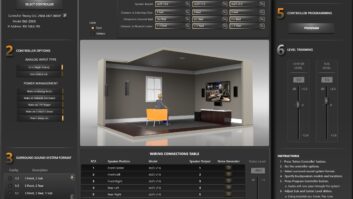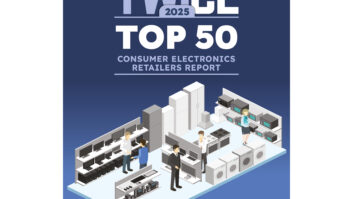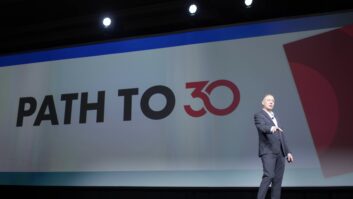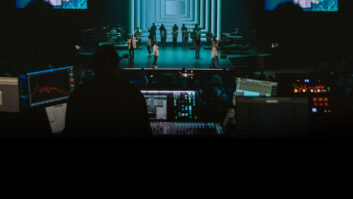The long-term future of computer software retailing may be strongly impacted by alternative methods of distribution such as online delivery. But retailers say that in today’s market — despite rapidly expanding retail floor space devoted to software — they are being overwhelmed by product. And the crush of software titles isn’t going to ease anytime soon.
“The biggest challenge for dealers is how to sift through the thousands of products and determine which ones will sell,” says Mary Bihr, director of sales and marketing at LucasArts Entertainment, a leading software developer.
And retailers aren’t the only ones wrestling with the problem — vendors and distributors are facing some of the same issues as products move down through the channels.
Retail merchandisers are under the gun to pick the winners, while vendors are fighting like never before for shelf space, and at the same, are facing shorter windows in which to prove their titles can achieve the turns a dealer requires. Distributors, as usual, are caught in the middle.
“The proliferation of titles is the single biggest problem in software distribution, and it’s a daunting problem,” says Seymour Merrin, president of Merrin Information Services, a consulting company.
Leslie Maltby, manager of sales promotions at Software City in Englewood, N.J., says she’s already facing that merchandising dilemma.
“We’re usually known as having one of the better software selections,” she says. “But how do you have all the hits, plus some of the other things you need to distinguish yourself from other people who just dabble in software, such as Wal-Mart or Sam’s?”
New technology — such as IBM’s joint venture with Hughes to transmit software data via satellite and burn disks and CD-ROMs at the store level — may help solve the problem in the future. In fact, although most vendors aren’t seeking to bypass retail, the storefronts’ inability to handle the deluge of conventional product will encourage alternative forms of distribution, Merrin believes.
“It’s going to result in more self-poisoning,” he says. For example, “we’ll see a lot more direct mail from publishers who can’t get their products on the shelves. It’s becoming a marketing and merchandising game, and the people who don’t understand marketing will fall by the wayside.”
At Minnesota-based Best Buy, senior VP of marketing for entertainment software Jeff Abrams sees another distribution threat for software retailers: the amount of “free” software being given away by PC hardware vendors.
“All this product being bundled in a PC certainly has an impact,” he explains. “If you want a PC just for a spreadsheet, word processor, and balancing your checkbook, you’ll never have to buy any more software.”
Although there are obvious signs of some immediate and long-term problems for software retailing, some industry veterans caution that it’s too soon to predict a major illness for conventional product distribution. Most indicators reveal a healthy and vigorous retail industry that has plenty of growth to go around.
“The future of software distribution can be considered very bleak, with electronic distribution and Microsoft sending everything on one CD and bypassing the retail channel,” says David Levine, director of marketing at hardware and software distributor Micro Center. “That has some validity. But in this industry we talk to ourselves, and we think that everybody is like us.”
“The installed base of PCs is around 28% to 30%,” Levine notes, “so we’ve got a long way to go. Each month, as new people enter the computer community, they still want a place to go where they can shop with a high-touch comfort level with high-tech products.
“Distribution and retailing isn’t going away, because you’ve got 60% of the population that is not using computers. The role of the retailer may be changing, but the channel will remain important.”
At Microsoft, Ed Belleba, director of retail strategy, says distribution at retail is broadening, not contracting: “What you have now is an industry becoming more of a typical consumer product business, with all different types of retailers today involved in selling software. Products are now available in all the different channels in which customers are comfortable shopping, so the issue for some vendors is the appropriateness of their products in each channel — some products sell better in some than others.”
LucasArts’ Bihr concurs, saying that as PC products make their way into more consumer homes, channels will continue to broaden.
“It used to be that computer products were carried by PC superstores,” she says. “Now, mass merchants, consumer electronics stores, and even bookstores, video stores and music stores are all incidental components of the retail distribution philosophy.”
Wherever PC software is sold, however, the current product glut creates a basic merchandising dilemma on the sales floor. For instance, how do you display all the titles?
“It’s brand-name versus category merchandising,” Ramaker says. “Do you put everybody’s product line together, or do you merchandise by category? As this category has evolved into more categories and SKUs, how do you break up a couple thousand SKUs?”
The answer, he adds, is a bit of both: Show the better-known brand products together, and group lesser-known products by content.
For publishers, it’s no longer enough to develop a product and package it in a sexy box. With shelf space in retail stores at such a premium, the key to distribution will be finding alternative ways to get the consumer’s eye to focus on your product.
“It’s going to force spine-out merchandising,” Merrin states. “That’s a great challenge to publishers to merchandise on the spine. It also means that retailers will be cherry-picking more and using much more stringent criteria to determine what’s going to stay and what’s not.”
The software industry’s transition to a mass market isn’t news, but the abruptness of the shift has been dramatic.
According to Fairfield Research, CD-ROM sales have moved solidly into that “other” category of general merchandise stores. Those retailers’ share of CD sales rose from 23% in 1994 to 56% in 1995 (see chart above), and computer stores and software specialists must accept that inevitable shift in distribution as software gains mass appeal.
“It’s going to happen. Deal with it,” declares Paul Ramaker, DMM at Media Play in Minneapolis. “Selfishly, we want the installed base to be greater. And then we want all that business. But with the installed base getting greater, the distribution gets greater.”
A more immediate concern is how to cope with an avalanche of product. Retailers are expanding their software displays, but they are hard-pressed to keep up with the pace of software introductions.
“You have too many people making too similar products,” Abrams says. “It’s getting to the point where the customer can’t make a decision. They’re not given the proper tools. A spreadsheet is a spreadsheet is a spreadsheet, once you get into the better-known brands.”
A basic reality is simply that retailers can’t carry anywhere near all the software titles available. “You’re left with carrying something just in case somebody wants it, what I call ‘just-in-case’ inventory. And that’s not good business,” Abrams explains.
So retail merchandisers are left with some tough decisions. “How many flight sims do you need to carry to satisfy the customer and still be profitable?” asks Ramaker. “You pick your hits, then hopefully you have some room in space and dollars to try some new products.”
Alan Bush, president of Computer City, offers one possible solution: Publishers could help reduce the number of software boxes by packaging different formats together.
“Software publishers need to have multiformat boxes — floppies, CDs, and maybe even Macintosh,” Bush says. “That will cut down on SKUs on the sales floor, and it will cut down on returns when consumers didn’t get the right format.”
As Company Exits Business, Dealers Snap Up AT&T PCs
By Amy Gilroy
In the wake of AT&T’s decision to leave the consumer PC business, rather than canceling AT&T orders, retailers are continuing to buy AT&T computers, opportunistically snapping up the lower minimum advertised prices (MAPs) offered by the company as it prepares to fold that business effective January 1.
Only one out of a half dozen retailers told TWICE it was considering canceling orders out of fear of a consumer backlash. But several buyers acknowledged that they were increasing orders for the remainder of the year while AT&T continued to build product and reduce MAPs by up to $200.
“No one’s calling to say they are returning AT&T product. AT&T is AT&T, whether they have a computer business or not. AT&T is not going out of business, and they are still going to have their support network,” one buyer said, summarizing the general view.
“We were not into them in a big way, but now we’re hoping to increase that,” said another buyer. “A lot of buyers are going to back out of them, so we’re looking forward to some good deals that we can make some money on. We have our own service contracts, so I’m not really worried.”
Following AT&T’s widely publicized breakup into three separate companies and its decision to exit the personal PC business, AT&T GIS Division informed retailers that it would lower the MAPs of its Globalyst consumer line by approximately $100 to $200, retailers report.
Minimum advertised pricing was said to be lowered as follows: Model 363 dropped from $1,799 to $1,699; Model 365 from $2,199 to $1,999; Model 373 from $2,199 to $1,999; Model 378, $2,399 to $2,199; Model 375, $2,499 to $2,299; and the Model 380 from $2,699 to $2,499.
Retailers said they expect further price reductions in the near future.
AT&T said it would continue to honor its warranties and provide service through its AT&T service centers, which remain intact to cover products such as ATMs and cash registers, according to retailers.
They also said that AT&T was claiming it will “go out in style” and offer full retail support.
An AT&T corporate spokesman could not be reached for comment, but the company issued a press release, stating: “AT&T GIS will continue to offer customers personal computers as part of total solutions, but will no longer develop and manufacture its Globalyst line of personal computers, nor sell them through retail outlets. The unit expects to announce a new relationship with a PC supplier soon” — presumably for business-to-business sales.
Reaction from buyers to AT&T’s departure generally ranged from regret to anger. Most said that the brand was beginning to enjoy strong sales, and they were sorry that AT&T was leaving the business.
One buyer said he was angry: “It couldn’t come at a worse time, going into Christmas. You’ve planned your business with them, and now we have to scramble for other lines. If any company should have made it, it should have been AT&T with their involvement with communication. I think it’s foolish on their part not to try to make it work. Based on everything they reported to us, they were doing well.”
Zafar Rizvi, director of merchandising for Rex Stores in Dayton, Ohio said that he was “really sad, because the people with whom I work, like Greg Presley and Angela Flenniken, really worked very hard to make AT&T successful. And I hate to see these people without jobs.”
Electronic PC SW Distribution Not Seen As A Serious Threat
By Lee Buchanan and James K. Willcox
Electronic distribution of software is a reality, but it’s not a serious concern for many retailers.
The industry has been toying with the notion of electronic distribution for years, from high-speed phone lines to broadcast delivery. But for the foreseeable future — which is admittedly a limited view in such a dynamic industry — electronic distribution is not expected to be much of a factor.
There are plenty of challenges facing software retailers and their distributors, but electronic distribution isn’t one of them, says Seymour Merrin, president of Merrin Information Services, a consulting company.
“Electronic distribution will be exceedingly limited, for an exceedingly limited category, for an exceedingly limited customer base,” Merrin says.
Efficient distribution may be a primary concern for software vendors, but consumers aren’t driven by that need for efficiency. “Most people just don’t like to shop that way, and they probably never will like to shop that way,” Merrin believes.
Alan Bush, president of Computer City, also dismisses electronic distribution as a potential threat to software retailers.
“There will be different delivery systems tried, but ultimately the consumer will go back to the retail store where they can try it out and get their questions answered,” Bush states. “We’ve yet to see someone try electronic distribution and win with it. It’s not a threat at all to our business.”
“Software may be a better candidate for online distribution, if you can see a demo of the product,” says Jeff Abrams, senior marketing VP for entertainment software at Best Buy. “Most consumers want a hands-on shopping experience where they can be in the store atmosphere to see what’s new. Shopping is an experience that’s never going to be replaced.”
Mandy Braun Strum, consumer section manager with the Software Publishers Association, says the vast majority of consumers aren’t ready for electronic distribution.
“When you consider the profile of the new consumer, I don’t see those consumers jumping from trying to figure out how to use their computer to electronic distribution via the Internet,” she explains.
Online distribution will have its place, predicts David Levine, director of marketing for distributor Micro Central, “it’s very close to becoming the distribution of choice for upgrades and completing software suites.”
Software vendors themselves downplay the impact electronic distribution will have in the immediate future on retail sales of their products.
Microsoft director of retail strategy Ed Belleba doesn’t see electronic distribution replacing retail sales in the near future: “While it is clearly another potential channel for certain customers who feel comfortable shopping at home, I see it as an augmentation of existing channels, not a replacement.”
However, alternative distribution methods could encourage retail stores to rethink the way they deal with their customers and provide an experience online interactions can’t replicate.
“You are already seeing some malls working very hard to position themselves as something other than just a place to shop by offering restaurants, classes and musical events,” Belleba says. “There will always be an experience that retail can do that online simply can’t.”
Belleba expects the biggest change in retail during the next five years to be “a wider range of choices where you can get computer-related products. Retail will absolutely continue to be viable.”
PowerBook Shipments Resume; Street Prices To Drop By $100
Apple Computer reported last week that it has resumed shipments of the PowerBook 5300 series, and Apple USA announced an immediate price reduction to U.S. dealers on purchases of the new PowerBook 5300 models.
The price reduction should result in an approximate U.S. street price drop of $100.
On September 14, Apple reported a safety problem with the lithium-ion battery packs in two early-production PowerBook 5300 units. Apple immediately halted shipments and has contacted virtually all customers (fewer than 1,000 worldwide) who have received the systems.
Apple has since replaced all of the lithium-ion batteries in these PowerBook models with nickel-metal-hydride (NiMH) batteries and has resumed shipments.
The new estimated street prices for PowerBook 5300 models, based on the price reduction to dealers, are expected to fall in the following price ranges: 5300, gray scale 8/500 MB, $2,099-$2,199; 5300cs, dual-scan color 8/500 MB, $2,699-$2,799; 5300cs, dual-scan color 16/750 MB, $3,399-$3,599; 5300c, active-matrix color 8/500 MB, $3,599-$3,799; 5300c, active-matrix color 16/750 MB, $4,399-$4,599; and 5300ce, active-matrix color 32MB/1.1GB, $6,399-$6,699.◊[headline]Canon Plans $25M Ad Campaign For New Color Bubble Jet Printers
[text]Canon Computer Systems Inc. (CCSI) has announced its most aggressive marketing plan in the computer company’s three-year history — a $25 million effort focused on its new line of color Bubble Jet printers.
The campaign includes CCSI’s first-ever TV advertising spots, which will appear during top prime-time network shows as well as major network sports and cable programming this fall.
Supporting the broad reach of TV will be hands-on demonstration events for consumers, including: a 10-city nationwide mall tour; a series of more than 500 “Demo Days” at major retail sites; a 7,000-mile van tour for press demonstrations; and print ads in consumer publications.
All of the ads and events are based on the theme, “What Can You Do With A Canon Printer?” The 30-second spot will begin to air this month and will appear on top prime-time network and cable TV programs, as well as late-night shows.
A two-page ad campaign will appear in leading general interest and PC-related magazines. The national mall tour will take place this fall in Atlanta, Boston, Chicago, Dallas, New York and Seattle, among other cities.
The Demo Days will be another prong of the marketing effort and will be held in partnership with Canon retailers such as Best Buy, Circuit City, Computer City, CompUSA and Staples.
In other company news, CCSI has signed an agreement with Ingram Alliance, enabling Canon’s line of printers, PC products, desktop products and notebooks, as well as the Notejet notebook with an integrated printer, to be distributed to corporate resellers.
Compaq Unveils TV Ad Campaign
Compaq Computer unveiled its new fall TV ad campaign focusing on the dramatic impact that Compaq’s home PCs are having on people’s lives.
The campaign poses the question, “Compaq — Has it changed your life yet?” and will debut nationally on TV during November. The budget for the campaign was not revealed at press time.
The marketing effort was unveiled in conjunction with the launch of new Compaq Presario PCs last month (TWICE, September 18, page 24). The units include the Presario 7100 desktop PC, the Presario 5500 Series, and the Presario 9500 Series.
Budget CD-ROM Titles Moving Into Grocery And Drug Stores
By Amy Gilroy
Budget CD-ROM software vendors continue to push into alternative retail channels, including grocery stores and drug stores, and they are forging a niche market estimated at a combined 4% of budget CD-ROM dollar sales and heading for over 15%, according to publishers and distributors.
Based on vendor estimates, over one third of the approximately 75 leading supermarket chains are stocking or test-marketing CD-ROM software, and some distributors claim that initial tests have met with success.
“So far all the tests we’ve been involved with have been successful, and the same is true for our competitors,” says Richard Greener, managing partner for Essex Interactive Media, which publishes and distributes budget software.
“The jewel box CD-ROM only came to market this January,” he notes, “so it has taken that long for people to test and evaluate it. Now, supermarkets and drug stores are showing a significant amount of interest.”
Essex is currently selling 48- to 192-title assortments of CD-ROMs, each priced at $9.99, at 2,100 Revco stores and 25 Payless Drug Stores.
This October, Greener says, Essex will ship to about 200 ShopRite supermarkets. It will also begin to test products in the Southern division of Albertson’s supermarkets, which will include 75 of the Boise, Idaho-based chain’s 800 stores, and in 12 Ralphs supermarkets in Los Angeles.
Another budget software vendor, Softkey, estimates that grocery and drug store outlets represent 6% of the company’s sales at present — though Eric Levin, manager of retail strategic sales and marketing, says that number is expected to climb to between 15% to 20% by the end of next year.
“We’re putting a pretty major focus on the supermarkets, and we’re having good success in placing certain kinds of products into the new channels,” Levin says. “Because of the way they do business and rotate product, we’re flowing in and out of 20 to 30 major supermarkets in the country, and there are maybe 75 total that have about 100 outlets or more.”
Supermarkets tend to rotate certain goods every 30 days so that an item may spend 30 days on the shelf, 60 days off, and 30 more back on, say suppliers.
Softkey says it will begin shipping this month to all 40 Star Market convenience stores based in Cambridge, Mass. with up to 57 titles, depending on the size of the location.
Levin expects to begin shipping to two major drug store chains this year but is waiting for the final purchase orders before announcing the names.
“Most drug stores sell The Pill Book near the pharmacy counter, and we have a title called Pharmacist, which is a similar CD-ROM, so that’s a channel that makes sense for us,” he says. “We expect to be in thousands of pharmacy outlets when it all comes together.”
Softkey is also test-marketing software at 100 of the 800 Cumberland Farm convenience stores.
Other software companies are also exploring the new grocery/drug store channel.
American Laser Games, for example, says that alternative channels as a whole represent 5% of its business and is expected to increase to 10%-15% of sales, according to marketing and sales VP Jonathan Leach. And Access Software says it is currently considering “a couple” of book stores and drug stores for its title Under A Killing Moon, a spokesman says.
Scott Addyman, president of budget software supplier Lasersoft, supplies 1,700 Florida-based Eckert Drug stores and says the company continues to test alternative channels but remains cautious.
“Years ago, when the software industry was selling flippies and floppies for $7.99 and $5.99, everyone went into the alternative channels, and they didn’t sell a lot,” Addyman notes. “We view it on an account-by-account basis.”
Ann Stephens, president of PC Data in Reston, Va., claims the jury is still out regarding the grocery and drug stores niche, because many companies are still in the test-marketing phase.
“The channel is constantly changing, and it has been forever,” states Stephens. “The first wave was to software-only stores in the mid-1980s, then it went to superstores, and then to mass merchants and consumer electronics stores.
“Now there’s talk of moving into drug stores and grocery stores. But the fact is that this may or may not happen. These mass merchants may decide to keep the category, and they may not.”
DATA BANK
SPA Software Sales Report:
North American PC Software Sales
SPA Software Sales Report:
North American PC Software Sales
(Millions Of Dollars)
First Half 1995 Over First Half 1994
DOS Windows Macintosh Other Total*
Entertainment 148.5% 95.9% 53.9% ** 108.9%
Home Education -74.7% 27.0% 13.5% -68.8% 1.5%
Finance -10.2% 110.0% 42.8% ** 53.4%
Word Processors -66.7% 24.0% -11.6% -24.7% 10.0%
Spreadsheets -75.0% -0.4% -2.6% -69.6% -8.3%
Databases -74.8% 2.0% -54.4% ** -16.0%
Integrated -69.9% 40.2% 13.2% ** 20.9%
Utilities -17.8% 24.4% 27.4% 100.5% -10.2%
Presentation Graphics -77.7% 22.7% -35.5% ** 10.2%
Drawing & Painting ** 50.9% -7.2% -38.1% 4.8%
Desktop Publishing ** -8.4% -41.9% ** -21.9%
Other Graphics -58.7% 45.2% 18.0% ** 23.3%
Project Management -62.6% 23.9% 18.1% ** 12.4%
PIMs ** 43.0% 18.3% ** 35.2%
Languages & Tools -48.3% 74.2% -53.0% 43.8%
Other Productivity -13.0% 74.9% -7.2% -14.0% 37.6%
Total -31.1% 26.5% -4.1% -12.8% 12.3%
Comparison Of North American PC Software Sales
(Growth Rate In Dollar Sales)
2nd Quarter 1995 Over 2nd Quarter 1994
DOS Windows Macintosh Other Total*
Entertainment 275.1% 107.7% 3.2% ** 135.9%
Home Education -79.3% 84.3% 3.3% ** 25.7%
Finance ** 297.6% ** ** 627.2%
Word Processors -63.1% 13.3% -5.6% -33.6% 3.5%
Spreadsheets -74.1% 8.7% 22.3% ** 0.3%
Databases -79.9% -30.4% -49.8% ** -39.1%
Integrated ** 10.6% 2.9% ** 2.3%
Utilities -18.2% -31.8% 15.4% 7.0% -19.5%
Presentation Graphics ** 35.0% -15.9% ** 23.5%
Drawing & Painting ** 41.6% -14.2% -32.7% -2.6%
Desktop Publishing ** 29.2% -28.5% ** 6.0%
Other Graphics -61.5% 37.8% -9.9% ** 12.7%
Project Management -58.7% -2.2% 71.6% ** -2.1%
PIMs 0.9% 26.4% 2.8%
Languages & Tools -49.1% 36.3% -54.2% ** 53.2%
Other Productivity -12.3% 56.6% -14.9% -14.8% 27.4%
Total -31.9% 18.9% -7.0% -28.4% 7.9%
* Totals may be slightly affected by rounding.
** Indicates a category with sales of less than $1.0 million or with too few firms to report. Source: SPA (Software Publishers Association) * TWICE 1995
Worldwide PC Software Revenue
(Millions Of Dollars)
2nd Quarter 1995
1st Qtr. 2nd Qtr. 2nd Qtr. 1st Qtr. 2nd Qtr. 1st Qtr.
Rank Rank Vendor Revenue Revenue Market Share Market Share
1 1 Microsoft $940.0 $808.7 41.8% 37.1%
2 2 IBM/Lotus $180.4 $198.2 8.0% 9.1%
3 3 Novell $130.9 $167.0 5.8% 7.7%
4 4 Adobe $116.5 $114.8 5.2% 5.3%
5 5 Symantec $92.0 $89.6 4.1% 4.1%
6 6 Intuit $45.0 $59.3 2.0% 2.7%
7 7 Claris $34.2 $37.9 1.5% 1.7%
8 8 Corel $33.1 $35.2 1.5% 1.6%
9 10 Softkey $26.2 $28.7 1.2% 1.3%
10 9 Borland $24.6 $32.0 1.1% 1.5%
Others $623.4 $606.2 27.8% 27.8%
Total $2,246.3 $2,177.6 100% 100%
Source: Dataquest (September 1995) * TWICE 1995
Over one-third
of the 75 leading supermarket chains
are stocking or testing
CD-ROM software.
“Software publishers need to have multi-format boxes — floppies, CDs and maybe even Macintosh.” — Alan Bush,
Computer City
“All this product being bundled in a personal
computer certainly has
an impact.” — Jeff Abrams,
Best Buy













